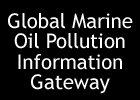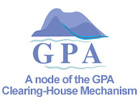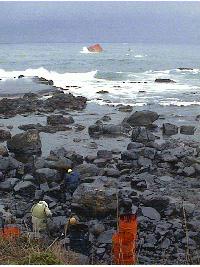|
International
actors and agreements in the region
 See
Global action and Global
actors.
See
Global action and Global
actors.
 UNEP
Regional Seas Programme. ••>
UNEP
Regional Seas Programme. ••>
 UNEP Global programme of action for the protection of
the marine environment from land-based activities (UNEP
GPA). ••>
UNEP Global programme of action for the protection of
the marine environment from land-based activities (UNEP
GPA). ••>
Regional
conventions, agreements, action plans and actors
 Action
Plan for the North-West Pacific (NOWPAP) • Regional
Coordinating Unit (RCU).
••>
Action
Plan for the North-West Pacific (NOWPAP) • Regional
Coordinating Unit (RCU).
••>
 Regional Activity Centres (RECs) of NOWPAP: ••>
Regional Activity Centres (RECs) of NOWPAP: ••>
-
Special Monitoring and Coastal Environmental Assessment
Regional Activity Center (CEA/RAC) — see also
Northwest Pacific Region Environment Centre (NPEC);
- Marine
Environmental Emergency Preparedness and Response
Regional Activity Centre (MER/RAC);
- Data
and Information Network Monitoring Regional Activity
Center (DIN/RAC).
 Memoradum
of Understanding on Port State Control for the Asia
and Pacific Region (Tokyo MoU). ••>
Memoradum
of Understanding on Port State Control for the Asia
and Pacific Region (Tokyo MoU). ••>
 UNEP Regional Office for Asia and the Pacific (ROAP).
••>
UNEP Regional Office for Asia and the Pacific (ROAP).
••>
 UNEP Regional Resource Centre for Asia and the Pacific
(RRCAP). ••>
UNEP Regional Resource Centre for Asia and the Pacific
(RRCAP). ••>
 UN Economic and Social Commission for Asia and the Pacific
(ESCAP). ••>
UN Economic and Social Commission for Asia and the Pacific
(ESCAP). ••>
 North Pacific Marine Science Organization (PICES). ••>
North Pacific Marine Science Organization (PICES). ••>
 Northwest Pacific Region Environmental Cooperation Center
(NPEC) .
••>
Northwest Pacific Region Environmental Cooperation Center
(NPEC) .
••>
 Eco
Asia
(Environment Congress for Asia and the Pacific). Consists
of high-level government officials (including ministers),
experts from international organizations and private
organizations and environment researchers in the region,
"where they can freely exchange viewpoints in their
personal capacities". The purpose of ECO ASIA is
to "promote long-term activities for environmental
protection by governments and relevant organizations
in Asia and the Pacific Region toward the realization
of sustainable development of the Region".
Eco
Asia
(Environment Congress for Asia and the Pacific). Consists
of high-level government officials (including ministers),
experts from international organizations and private
organizations and environment researchers in the region,
"where they can freely exchange viewpoints in their
personal capacities". The purpose of ECO ASIA is
to "promote long-term activities for environmental
protection by governments and relevant organizations
in Asia and the Pacific Region toward the realization
of sustainable development of the Region".
|
 |
Regional
and national reports on the state of the marine and
coastal environment
 UNEP
Regional Seas: "The North-West Pacific is among
the most highly populated parts of the world, resulting
in enormous pressures and demands on the environment.
Its people are particularly dependant on the sea for
their food and livelihoods. Yet their health –
and the health of their environment – are under
growing threat, mainly from land-based activities and
sources of pollution. Coastal development, industry,
transport, and activities such as land reclamation and
intensive mariculture take an ever-greater toll on coastal
ecosystems. Chemical and industrial wastes, untreated
municipal sewage, agricultural pesticides and nutrients
in run-off cause widespread damage and stimulate eutrophication
and harmful algal blooms (red tides). Added to these
are oil pollution from wastewaters and accidental spills,
atmospheric pollution and marine and coastal litter.".
UNEP
Regional Seas: "The North-West Pacific is among
the most highly populated parts of the world, resulting
in enormous pressures and demands on the environment.
Its people are particularly dependant on the sea for
their food and livelihoods. Yet their health –
and the health of their environment – are under
growing threat, mainly from land-based activities and
sources of pollution. Coastal development, industry,
transport, and activities such as land reclamation and
intensive mariculture take an ever-greater toll on coastal
ecosystems. Chemical and industrial wastes, untreated
municipal sewage, agricultural pesticides and nutrients
in run-off cause widespread damage and stimulate eutrophication
and harmful algal blooms (red tides). Added to these
are oil pollution from wastewaters and accidental spills,
atmospheric pollution and marine and coastal litter.".
 State of the Environment in Asia and the Pacific 2000.
UN Economic and Social Commission for Asia and the Pacific
(ESCAP).
State of the Environment in Asia and the Pacific 2000.
UN Economic and Social Commission for Asia and the Pacific
(ESCAP).
 UNEP: Global
Environment Outlook 3 (GEO3). Coastal and marine
areas.
UNEP: Global
Environment Outlook 3 (GEO3). Coastal and marine
areas.
 University
of Rhode Island: Large Marine Ecosystems (LME): The
region includes East
China Sea, Yellow
Sea, Kuroshio
Current, Sea
of Japan,
Ohashio Current, and Sea
of Okhotsk.
University
of Rhode Island: Large Marine Ecosystems (LME): The
region includes East
China Sea, Yellow
Sea, Kuroshio
Current, Sea
of Japan,
Ohashio Current, and Sea
of Okhotsk.
 China
State of the Environment Report
(1998). In the section on coastal and marine environment,
20 oil spills (one of which was large) were reported
in 1997. UNEP Net.
China
State of the Environment Report
(1998). In the section on coastal and marine environment,
20 oil spills (one of which was large) were reported
in 1997. UNEP Net.
 Conservation
of the marine environment, Japan. Ministry of the
Environment.
Conservation
of the marine environment, Japan. Ministry of the
Environment.
Private
sector and NGOs actors and initiatives
 Oilwatch.
••>
Oilwatch.
••>
 International Tanker Owners Pollution Federation (ITOPF).
••>
International Tanker Owners Pollution Federation (ITOPF).
••>
 International Directory of Oil Spill Cleanup Contractors
and Response Organisations. ••>
International Directory of Oil Spill Cleanup Contractors
and Response Organisations. ••>
 International Petroleum Industry Environmental Conservation
Association (IPIECA). ••>
International Petroleum Industry Environmental Conservation
Association (IPIECA). ••>
 Pacific
Environment. A U.S.-based international environmental
organization that supports the work of over 80 environmental
NGOs in China, and Russia. See the case of oil drilling
at the Sakhalin
Island, off the coast of Russia and just north of
Japan.
Pacific
Environment. A U.S.-based international environmental
organization that supports the work of over 80 environmental
NGOs in China, and Russia. See the case of oil drilling
at the Sakhalin
Island, off the coast of Russia and just north of
Japan.
National
action
 Ministry of Land, Infrastructure and Transport of Japan:
Maritime
Department
Ministry of Land, Infrastructure and Transport of Japan:
Maritime
Department
 Japan
Coast Guard. The tasks of the Japanese Coast Guard
and Rescue Department include maintainence of public
order, oil pollution response and search and rescue.
Japan
Coast Guard. The tasks of the Japanese Coast Guard
and Rescue Department include maintainence of public
order, oil pollution response and search and rescue.
|



